
nattu vaidya
the barefoot doctor
Throughout India, people receive medical help from both qualified and non-qualified practitioners. As we have noted previously, there are four traditional systems practiced in India — Ayurveda, Siddha, Unani and Tibetan medicine — all of which are based on humoral pathology. Since Independence in the 1940s, each has built up a solid base of medical colleges imparting education in five-and-a-half year programs. They have been joined by a fifth: the study of Naturopathy. Currently, only graduates of such recognized medical schools are legally entitled to practice medicine, and it is believed that there are around 600,000 such licensed practitioners.
Be that as it may, there are, in addition, literally hundreds of thousands of nonqualified healers servicing the health and welfare needs of India’s huge population. Often, they comprise families that have practiced their individual skills for centuries — and are well known in the community. Some such practitioners may have some rudimentary education as well, but economic and other factors may have resulted in their medical training being cut short. Others are completely unqualified on paper, indeed they may even be illiterate, but they are the recipients of countless generations of healing knowledge.
As such, they are hugely skilled — and a vital part of any community.
There are numerous examples of such traditional healers, all of whom fall into a category that can loosely be termed the “barefoot doctor” or nattu vaidya.
The village midwife:
Each village has at least one traditional birth attendant known as a dai. These women are skilled in delivering not only healthy babies, but have knowledge of breach births, stillborn fetuses and babies with umbilical cords round their necks. Often coming from a family of midwives, they are skilled in ante-natal and post-natal care as well.
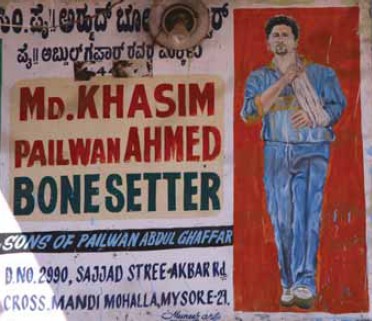
A sign by the door of Mysore-based Mohammed Khasim’s practice. The son of Abdul Gafar, a renowned bone specialist who treated the Maharajah of Mysore’s family, his skills have been handed down from father to son.
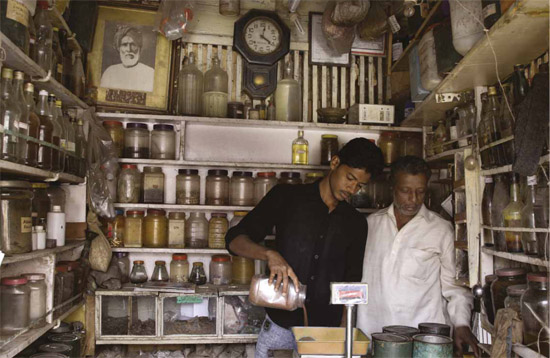
Even though there are thousands of Unani doctors, more than 100 medical colleges and a dozen major pharmaceutical companies in India, the roadside pharmacy overflowing with dusty medicine bottles, dried roots, powders and oils is a common sight. Here, a father and son (both unqualified) prepare prescriptions in their small shop. The boy’s grandfather taught them all they know.

Many nattu vaidya learned their skills from their families. This physician is no exception. Although not formally qualified, he has practiced Ayurveda in Trivandrum for over 50 years and has many regular patients. He makes most of his prescriptions himself, to recipes that were handed down to him from his father.
The bonesetter:
The traditional bonesetter or orthopedic healer is another example. In the countryside, such a person may look after the needs of the population of 20 villages or so, walking from one destination to the next to treat sprains, fractures, joint problems or muscle pain. A group involved in strengthening traditional systems of medicine called the Lok Swasthya Parampara Samvardhan Samithi (LSPSS) in Coimbatore estimates that there are over 60,000 bone-setters serving rural populations and, in cities, established practitioners may see up to 30 or 40 patients a day. It is estimated that over 50 percent of people with broken bones are treated by bonesetters in any given year.
The poison healer:
Snakebite is a common occurrence in rural India and traditional visha vaidya have specialist knowledge. They can differentiate between different snakebites, and they know which antidote works for which type of snake. Their remedies are almost always herbal and prescriptions include purgation, antidotes and topical application of specific plants. The visha vaidya is often called on in the case of rabid dog bites and scorpion bites too.
Less clear cut, but nonetheless important, are people like oil producers, small-scale herbal medicine manufacturers, wandering monks with herbal knowledge, community elders who have specialist knowledge of herbal home remedies and nutrition, martial art masseuses, and kannu vaidyas or eye physicians who treat eye complaints even to the extent of giving cataract operations. There are also more general herbal medicine practitioners who specialize in such conditions as jaundice and paralysis, children’s diseases and dentistry.
Such people may have very particular knowledge in marmanam (treatment of the vital points), agni and kshara karma (cauterization), sodhana karma (purification techniques) and rasayana (rejuvenation therapy) as well. According to the Foundation for the Revitalisation of Local Health Traditions (FRLHT) whose mission is to revitalize these health practices in four states in south India, there could be a million such practitioners catering to India’s 4,600-odd ethnic communities.
Traditionally, many of these care-givers have a relationship with their “patients” and don’t practice specifically for monetary gain. Rather, they place value on a code of ethics that includes service to others, the transference of skills, prayers for guidance and holistic health care for all. In some cases, practitioners accept a kanikkae (a kind of offering or a gratuity). Theirs is not a vocation; in fact, it is more than likely that they have another job, such as farmer or shopkeeper, as well.
Even though most of these people do not have legal status (or only semi-legal status) as medical practitioners, they are considered legitimate healers in their own right. Indeed, such organizations as the LSSPS are keen to tap into their specialist knowledge — some of which is invariably being lost with the passing of time. For a start, none of it is written down: Most barefoot doctors receive their healing knowledge orally via person-to-person transmission either in the form of the guru- shishya tradition (master/ disciple), or commonly from father to son or mother to daughter. Secondly, with rapid industrialization and loss of rural land, vital herbs, plants and trees are being cut down in the name of “development”. Thirdly, as India develops, a worrying trend has been recently noticed: such people are quite often over 40 years of age, and are often not handing down their skills to the next generation as they did in the past.

Dr S B Nithyanandam stands in the grounds of his local Shiva temple. A Siddha doctor, he learnt his trade from his father, but also trained at a Siddha medical college.
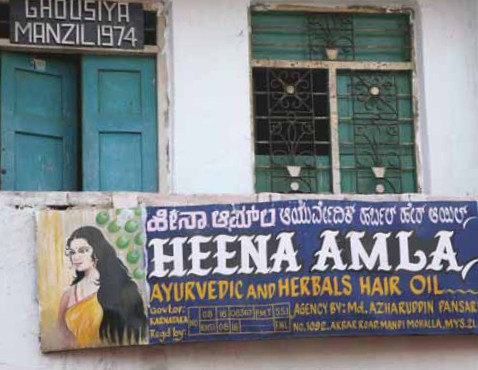
An example of the type of colorful billboards found all over India. This one is for a type of hair oil that contains amla or Indian gooseberry.
healing plants
India’s creative healing systems are predominantly plant-based (although minerals have a role) and it is estimated that most households rely upon locally available plant material for their pharmacopeia. According to the World Health Organisation (who), between 35,000 and 70,000 plants have been used for medicinal purposes globally at one time or another — and in India today at least 20,000 species are found, 2,000 of which are efficacious in Ayurvedic formulations. Of these, about 600 are commonly used in oils (tailam), powders (choornam), internal medications, teas and tonics. We list some of the most important plants from the Ayurvedic pharmacopeia.
Lawsonia inermis Henna
Henna (mehndi) is commonly used as a dye and an anti-fungal. The leaves produce a red-orange dye molecule that has an affinity for bonding with protein, so has been used to dye skin, hair, fingernails, leather, silk and wool since the Bronze Ages. In India it is commonly used as a dye on hands, feet and hair, while henna essential oil is used as a scalp stimulator.
Centella asiatica Asiatic pennywort
Brahmi is a small herbaceous annual plant, the leaves of which are reported to be useful in abdominal disorders; a tea is made to help with dysentery in children. Scientific reports have documented its ability to aid wound healing, being particularly helpful with reduction of scarring, and it is also used in the treatment of leprosy, epilepsy, cardiac debility and more.

Eclipta alba False daisy
Bhringaraja is an annual herb that is commonly used in the treatment of skin diseases and as an anti-inflammatory. It is also reported to be effective in blackening and strengthening the hair and is cooling on the head. It may also be taken as a tonic to help with liver and spleen enlargements.
Ocimum tenuiflorum Holy basil
Known as holy basil, tulsi is an important symbol in many Hindu religious traditions. It is mentioned in the Rigveda and the Charaka Samhita, and has been recognized by the rishis for thousands of years as a prime herb in Ayurvedic treatment. Tulsi extracts are used for common colds, headaches, stomach disorders, inflammation, heart disease, poisoning and malaria. Tulsi can be taken as an herbal tea, in dried powder form, fresh or mixed with ghee.
Adhatoda vasica Malabar nut
Also known as the Malabar nut tree, the vasaka shrub has leaves (see left) that are rich in vitamin C and carotene. Fresh or dried leaves are used to make a tea that is good for bronchial and asthmatic troubles. Powdered leaves are used on skin infections, and a preparation made from vasaka flowers is used to treat tuberculosis.
Chrysopogon zizanoides Vetiver
Native to India, vetiver is a Tamil name and old Tamil literature lists medicinal uses for the plant. Similar to other fragrant grasses such as lemongrass and citronella, Chrysopogon zizanoides is a perennial grass. The root has cooling and calming properties, so is effective in the treatment of burns, while oil of vetiver, known as the oil of tranquility, is a key ingredient in perfumes. Vetiver is antiseptic, sedative and stimulating also.

Dashmool “Ten Roots”
Datura stramonium L. Thorn apple
The thorn apple or shivpriya grows in India as a wasteland weed. Ancient Hindu physicians regarded it as intoxicant, emetic, digestive and heating. The dried leaves, flowering tops and seeds are used in indigenous medicine in the treatment of asthma and bronchitis, while the whole plant is used as a muscle relaxant. The fruits, when crushed, are used in a paste form to reduce swelling and pain.
Emblica officionalis Indian gooseberry
The Indian gooseberry or amla (overleaf) is a very important Ayurvedic fruit, used in the treatment of liver conditions, jaundice, anaemia and diabetes. It is an immune system booster and is high in vitamin C. Triphala, an Ayurvedic combination of amla, haritaki (Terminalis chebula) and vibhitika (Terminalis belerica) is used as a laxative and for headaches, biliousness, dyspepsia, constipation, piles and enlarged liver.
Coleus zeylanicus No English name
The coleus zeylanicus plant has anti-bacterial, deodorant and cooling properties, and is used in urinary infections and digestive problems. Known as ambu in Sanskrit and hribera in most other places in India, its flat silver leaves are used to reduce body temperature and fever.
Solanum xanthocarpum Poisonberry
This is one of the dashmool (ten roots) of Ayurveda and it is found in 50 percent of Ayurvedic preparations. It is a spiny diffuse herb that grows wild in India: The juice of the berries is used in sore throat. Roots and seeds are administered as an expectorant in cough, while the stem flowers and fruits are prescribed for relief in burning sensation in the feet. It is anervous system regulator, good for the liver and asthmatic conditions.
Maranta arundinacea L. Arrowroot
The creeping rhizome of the arrowroot is used to stop vomiting and it is good for the digestion. It helps relieve acidity, indigestion and colic and exerts a mildly laxative effect on the large bowel. When mixed with hot water, the root starch become gelatinous, so soothes irritated mucous membranes.
Azadirachta indica Neem
The fast-growing neem tree (see page 140) has many medicinal properties, as it is a known purifier and antiseptic. Conditions ranging from digestive disorders to diabetes and from high cholesterol to cancer may be helped with neem, while purifying neem twigs are a traditional tooth cleaner in India. All parts of the tree are used; neem also makes fine soaps, shampoos, balms and creams.

Coconut
Sida cordifolia No English name
The bala plant is associated with the Hindu Goddess of beauty and grace Parvati and it is part of the magical trio of herbs associated with women in Indian herbology (the other herbs that are recommended for beautifying women are ashoka and shatavari). Bala oil is recommended for all disorders produced by the derangement of vata, and recently an Ayurvedic tailam (containing ashwagandha and bala root and Celastrus oils) was clinically proven to be effective for neuralgia in controlled studies in Germany.
Cocos nucifera Coconut
The name for the coconut palm in Sanskrit is kalpa vruksham translating as “the tree which provides all the necessities of life”. The term coconut refers to the nut (see above), which is widely used in Ayurveda both externally for its oil and internally as food. Charaka said that tender and half-mature coconuts increase the quantity and quality of all seven tissues and are vata pacifying, cooling and strengthening.
Oxalis corniculata Yellow wood sorrel
An annual herb, yellow wood sorrel or puliyarila has diuretic and refrigerant properties. It is used to treat disorders of the liver and digestive problems. The leaf pulp is applied over insect bites and burns. It has antibacterial properties and is high in Vitamin C.
Eupatorium triplinervie No English name
Known as yapana, the leaves of this ground-covering shrub are used for digestive disorders, piles (as it has haemostatic properties), nervine disorders and asthma. It is also used to bring down fevers as it is antipyretic.
Calycopteris floribunda No English name
Known as pullani or ukshi, this woody climber is used in Ayurvedic remedies for malaria, dysentery and snakebite. Its essential oil is supposed to be useful for depression as it has grounding properties.
Elaeocarpus sphaericus No English name
This small tree is famous for supplying the ridged fruits that are dried and used as medicinal “beads” in rudraaksh or garlands worn to stave off evil or illness. The fruits are used in Ayurveda for mental diseases, epilepsy, asthma, hypertension, arthritis and liver diseases.
Pandanus amaryllifolius Pandan
The long leaves of the pandan or screwpine plant known as rumbha in south Asia are used as a flavoring in food, but are also known medicinally for aiding digestion. The leaves are also believed to contain an anti-viral protein that may be useful in the case of influenza.
Bacopa monnieri No English name
Known as bhrami (as are some other herbs) this creeping herb has antioxidant properties and has been used for centuries in cases of epilepsy. It is believed to boost the memory, increase concentration and reduce anxiety. It forms part of an Ayurvedic cure for inflammatory bowel syndrome.
Melastoma malabathricum L. Straits rhododendron
A perennial shrub with bright purple flowers, this is used to treat diarrhea, dysentery and piles, and is also useful in uterine diseases.
Aloe barbadensis Aloe vera
Highly prized for the liquid contained in its thick, fleshy blades, aloe vera is revered for its cooling properties. It is used externally for skin rashes, sunburn, itchiness, scarring and psoriasis, as it is antibiotic and antiseptic in nature. It is also a purgative and anti-diabetic, so can be taken internally to aid the digestion.

Indian gooseberry

Holy Basil
Areca catechu Arecanut
Commonly known as betel, the arecanut comprises part of the Indian recreational digestive known as paan. The dried nut has stimulant and astringent properties and is used to sweeten the breath and strengthen the gums. It is used in Ayurveda to combat inflammatory bowel syndrome and the skin of the fruit is used as an anti-poisonous substance for insect bites.
Cinnamomum zeylanicum Cinnamon
A small bushy tree, the dried leaves and bark of the cinnamon tree are used as a spice, medicinally and for cosmetic purposes. The powdered bark is considered a brain tonic, while a decoction of the leaves aids the digestion. It is believed to alleviate anxiety and depression and helps clear the respiratory channels. In Ayurvedic beauty products, it improves the complexion and adds fairness to skin.
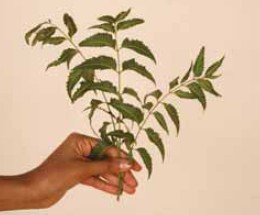
Neem
Caryophyllus aromaticus Clove
The dried unopened flower bud of a small tree, the clove has both culinary and medicinal uses. It is a stimulant and an antiseptic, so is used in a variety of Ayurvedic medicines: it helps gastric irritability, aids the digestion and enhances circulation and metabolism. The essential oil of clove is used to relieve pain from toothache and as an oral hygiene product.
Theobroma cacao Cacao
Used to make cocoa and chocolate, cacao beans also form the basis for cocoa butter, an all-natural vegetable fat. It is used in a variety of Ayurvedic beauty preparations as it is extremely rich. Often combined with jojoba oil, it is used for sunburn, as a skin softener and to reduce scar tissue and stretch marks from pregnancy.
Murraya koenigi Curry leaf
Found in many Indian backyards, the curry leaf plant is a staple in Indian cuisine. However, its leaves also aid the digestion as it is mildly laxative, and the powdered root and bark is used for relief from kidney pain. Traditional healers often used crushed leaves on topical applications of insect bites in the form of a poultice.
Zingiber officinale Ginger
Ginger is used widely in both Ayurvedic and Unani medicine. Charak, the ancient sage of Indian medicine, said: “Every good quality is found in ginger”, and other texts suggest that everyone should eat fresh ginger before meals to enhance the digestion. It is also believed to clear the micro-circulatory channels of the body, help with joint pain and motion sickness and facilitate absorption of nutrients into the system.
Cymbopogon citrates Lemongrass
A medicinal plant, lemongrass is used in Ayurvedic herbal teas for pitta types, while the essential oil is a useful insect repellant. It is also widely used in perfumes and cosmetics, and Ayurvedic texts indicate that it is a useful stress-reliever and cleanser when placed with other herbs in a steam box.
Mentha arvensis Mint
Called paparaminta in Hindi, mint is indigenous to India and is widely distilled for its antiseptic and antispasmodic oil. Helpful for headaches, rheumatism and neuralgia, mint is also used in teas to prevent vomiting and boost a weak digestive system. A popular ingredient in Ayurvedic herbal toothpastes and soaps, it is a cooling herb with a pungent aftertaste.

Ginger
Curcuma domestica Turmeric
An all-round wonder rhizome, the majority of herbal healers use turmeric. Its benefits are too numerous to mention, but its most common uses are for detoxifying the liver, balancing cholesterol levels, fighting allergies, stimulating the digestion, boosting immunity and enhancing the complexion. Sushruta recommended it for epilepsy and bleeding disorders, while Charaka said it was useful in skin diseases, as a mind/body purifier and to help the lungs expel kapha.
Cananga odorata Ylang ylang
Oil from the greenish-yellow flowers of ylang ylang (see right, top) is relaxing and tension relieving. It is also recommended as an anti-depressant. It has an erotic, sweet, fruity smell so is widely used in perfumery. Ylang ylang is also believed to regulate and balance skin texture.
Withania somnifera Indian winter cherry
Also known as the Indian winter cherry, ashwagandha root (see page 130) is sometimes called Indian ginseng as it is used in Ayurveda extensively. It has antioxidant properties and is also an immune system booster; its anti-inflammatory and pain-reducing properties make it useful in the treatment of arthritis, and many Indians believe it promotes longevity.
Glycyrrhiza glabra Licorice
Famous for its distinctive flavor, licorice (see above) is used in traditional herbal medicine as a liver detoxifier and endocrine system booster. It is also useful for a variety of bronchial problems and in India licorice sticks were (and still are) commonly used as teeth-cleaners.

Ylang ylang
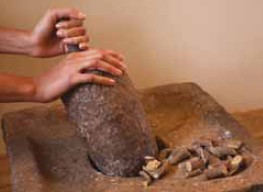
Licorice
Camellia sinensis Tea
Widely drunk throughout India, many people do not realize the medicinal benefits of this ubiquitous plant when they drink a cup of tea. Tea is an effective antioxidant; it stabilizes blood lipids, thus helping in reducing cholesterol; it helps with hypertension; and is an effective immune system booster.
Dashmool “Ten Roots”
The powder obtained from what is known in Ayurveda as dashmool or “ten roots” (see page 137) is used in over 50 percent of Ayurvedic preparations. The potent combination of these ten roots’ properties has resulted in a powder that may be taken internally in the form of pills, rubbed on the body in the form of powders, or used externally and internally as an oil. Dashmool has exhaustive healing properties, balancing all three doshas, reducing ama disorders, reducing numbness and stiffness in the body, and helping with pain management.
ayurvedic preparations


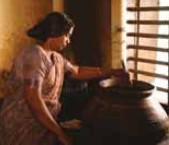
Ancient machinery grinds and reduces ingredients into a thick black paste-like consistency; this is then used to make pills or gulikam. Sida cordifolia roots are cut, washed, then crushed before being boiled and reduced (often many times); the result is a bala decoction. While boiling, oils have to be constantly stirred. Open fires at a production facility in Kerala. Brass, copper or large iron cauldrons are used for oil production.
Ayurveda, Siddha, Unani and Tibetan traditional medicine all use materials from the earth in prescriptions. In most cases, the ingredients are not simply plucked and used, but undergo certain preparatory procedures before they are considered ready for use. Ayurvedic doctors stress the link between freshness and efficacy in the case of herbs and plants, whilst materials from the ground (metals, minerals and so forth) undertake complicated and time-consuming purification processes.
In Ayurveda, some preparations are used internally, others are reserved for external use and some can be used for both. For the most part, oils (thailam), powders (choornam), raw herbal pastes (kalkam) and processed herbal pastes (leham) are widely used as topical applications. Internal prescriptions include fermented preparations such as asavam and arishtam (both decoctions, the former made without heat, the latter with heat), medicated ghees or gritham, bhasmas (incinerated fine powders) and gulikam (pills). None are easy to make.
Depending on the size and scale of the Ayurvedic establishment, medicines and oils are either sourced from reputable manufacturing companies or pharmacies, or made on site. It is usually the smaller concerns that grow or locally source their own ingredients, and make their own medicines. Dr P Sathyanarayanan, a third-generation Ayurvedic doctor but also a qualified doctor from the Ayurvedic College in Coimbatore, runs an Ayurvedic homestay with his wife. “We have centuries of tradition behind us,” he explains, “but also modern facilities and a home-away-from-home environment. All our medicines are made on site in our production facility, and we individually custom-make prescriptions for our patients.”
Exploring the production facility is an eye-opener: each oil or powder or pill has to go through numerous processes before it is ready for use. The procedures are time-consuming, made-by-hand and labor-intensive, but this “return to basics”, in Dr Sathyanarayanan’s opinion, is the true route for authentic Ayurveda.
Many agree with him. Punarnava, a Coimbatore-based Ayurvedic consultancy that helps link patients with suitable Ayurvedic doctors and homestays, embraces the concept of “living in the present but drawing on traditions from the past to look to the future.” Their doctors believe that the “real” Ayurveda is a potent combination of ancient knowledge, logical, ethical and spiritual practice, a caring environment, correctly administered procedures and authentically prepared medicines. If all the above practiced, they believe that Ayurveda and Ayurvedic medicines have a bright future.

The Aditya storage cupboard is constantly replenished. Ayurvedic preparations should always be stored in air-tight bottles.
listings

Ayurve dic Hospitals, Homestays and Treatment Centers:
Indus Valley Ayurvedic Center
Kalari Kovilakom
http://www.kalarikovilakom.com
The Arya Vaidya Chikitsalayam
Keraleeya Ayurveda Samajam
Kerala Ayurveda Ltd
Vasudeva Vilasam Ayurveda Pharmacy
Aditya Ayurveda Hospital
email: sathyan12@sancharnet.in
Thulasi Ayurveda Chikitsalayam
email: ramananddr@sancharnet.in
Swaasthya Ayurveda Village
Poomully Aramthampuran’s Ayurveda Mana
Holistic Health Centers:
SOUKYA International Holistic Health Centre
Ayurve dic Consultants:
Punarnava Ayurveda Private Limited
http://www.punarnava-ayurveda.com
Hotels and Resorts with Spas:
Kumarakom Lake Resort
Park Hotels
Ananda – In The Himalayas
Taj Hotels, Resorts and Palaces
Neemrana “non hotel” Hotels & Resorts
Shangri-La Hotels and Resorts
Mandarin Oriental Hotel Group
http://www.mandarinoriental.com
CGH Earth Hotels
JW Marriott Mumbai
Aman Resorts
The Oberoi Group
Yoga and Meditation Schools and Retreats:
Shreyas Reetreat
Mysore Mandala Yogashala
Ashtanga Yoga Research Institute
Vipassana Research Institute
Swaswara Resort
Salon, Spa and Product Companies:
Shahnaz Husain Group of Companies
Sansha Spas